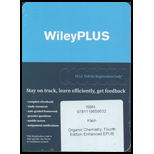
ORGANIC CHEMISTRY-ACCESS PACKAGE
4th Edition
ISBN: 9781119833130
Author: Klein
Publisher: WILEY
expand_more
expand_more
format_list_bulleted
Question
Chapter 15.7, Problem 5LTS
Interpretation Introduction
Interpretation: For the given structures the multiplicity of each signal to be identified.
Concept Introduction:
Multiplicity: The number of peaks on the each signal in NMR spectrum is defined as multiplicity; the multiplicity of each signal indicates the neighboring protons. It is generated by coupling of the subjected protons with the neighboring protons (both subjected and neighbor protons are to be chemically not equivalent) separated by either two or three sigma bonds.
Rule: Multiplicity of each signal is calculated using
Expert Solution & Answer
Trending nowThis is a popular solution!

Students have asked these similar questions
show any electrophilic aromatic substitution, identify the electriphile, nucleophile and transition state
Write balance molecular, total and net ionic equation for
Copper(II) Sulfate and Ammonium Chloride
starting with CH3CH2CH2OH make 2 butanol and 2 methyl 2 butanol
Chapter 15 Solutions
ORGANIC CHEMISTRY-ACCESS PACKAGE
Ch. 15.4 - Prob. 1LTSCh. 15.4 - Prob. 1PTSCh. 15.4 - Prob. 2PTSCh. 15.4 - Prob. 3PTSCh. 15.4 - Prob. 4ATSCh. 15.4 - Prob. 2LTSCh. 15.5 - Prob. 3LTSCh. 15.6 - Prob. 4LTSCh. 15.6 - Prob. 11PTSCh. 15.6 - Prob. 12PTS
Ch. 15.6 - Prob. 13PTSCh. 15.7 - Prob. 5LTSCh. 15.7 - Prob. 15PTSCh. 15.8 - Prob. 6LTSCh. 15.8 - Prob. 19PTSCh. 15.10 - Prob. 8LTSCh. 15.10 - Prob. 23PTSCh. 15.10 - Prob. 24PTSCh. 15 - Prob. 32PPCh. 15 - Prob. 33PPCh. 15 - Prob. 34PPCh. 15 - Prob. 35PPCh. 15 - Prob. 36PPCh. 15 - Prob. 37PPCh. 15 - Prob. 38PPCh. 15 - Prob. 39PPCh. 15 - Prob. 40PPCh. 15 - Prob. 41PPCh. 15 - Prob. 42PPCh. 15 - Prob. 43PPCh. 15 - Prob. 44PPCh. 15 - Prob. 45PPCh. 15 - Prob. 51PPCh. 15 - Prob. 52PPCh. 15 - Prob. 53PPCh. 15 - Prob. 54PPCh. 15 - Prob. 55PPCh. 15 - Prob. 56PPCh. 15 - Prob. 57PPCh. 15 - Prob. 72IPCh. 15 - Prob. 73IPCh. 15 - Prob. 74IPCh. 15 - Prob. 75IPCh. 15 - Prob. 76IPCh. 15 - Prob. 77IPCh. 15 - Prob. 78IPCh. 15 - Prob. 79IPCh. 15 - Prob. 80IPCh. 15 - Prob. 81IP
Knowledge Booster
Similar questions
- option choice: Isoleucine Histidine Threonine Alanine Lysine Aspartate Tryptophan Tyrosine Leucine Arginine Cysteine Asparagine Valine Glutamine Glycine Methionine Serine Proline Phenylalanine Glutamatearrow_forwardsketch the nature of the metal-alkylidene bonding interactions.arrow_forwardPart C The perspective formula of isoleucine, an amino acid, is provided below. HOOC H₂NIC H 川 CH3 CH,CH3 Draw the Newman projection in staggered conformation for isoleucine by viewing the molecule along the C-2-C-3 bond. 1. Edit the Newman projection on the canvas. 2. Replace the appropriate hydrogens with the appropriate -CH3 or other groups. 3. If you need to start over, Undo or choose a Newman projection from the Templates toolbar (bottom). Important: Never delete the hydrogen atoms or bonds directly attached to the template, and do not move them by dragging or dropping them. That will break the projections structures. Only replace them! ▸ View Available Hint(s) 0 2 H± 3D EXP. L ד י CONT. 2 H 0 N оarrow_forward
arrow_back_ios
SEE MORE QUESTIONS
arrow_forward_ios
Recommended textbooks for you
 ChemistryChemistryISBN:9781305957404Author:Steven S. Zumdahl, Susan A. Zumdahl, Donald J. DeCostePublisher:Cengage Learning
ChemistryChemistryISBN:9781305957404Author:Steven S. Zumdahl, Susan A. Zumdahl, Donald J. DeCostePublisher:Cengage Learning ChemistryChemistryISBN:9781259911156Author:Raymond Chang Dr., Jason Overby ProfessorPublisher:McGraw-Hill Education
ChemistryChemistryISBN:9781259911156Author:Raymond Chang Dr., Jason Overby ProfessorPublisher:McGraw-Hill Education Principles of Instrumental AnalysisChemistryISBN:9781305577213Author:Douglas A. Skoog, F. James Holler, Stanley R. CrouchPublisher:Cengage Learning
Principles of Instrumental AnalysisChemistryISBN:9781305577213Author:Douglas A. Skoog, F. James Holler, Stanley R. CrouchPublisher:Cengage Learning Organic ChemistryChemistryISBN:9780078021558Author:Janice Gorzynski Smith Dr.Publisher:McGraw-Hill Education
Organic ChemistryChemistryISBN:9780078021558Author:Janice Gorzynski Smith Dr.Publisher:McGraw-Hill Education Chemistry: Principles and ReactionsChemistryISBN:9781305079373Author:William L. Masterton, Cecile N. HurleyPublisher:Cengage Learning
Chemistry: Principles and ReactionsChemistryISBN:9781305079373Author:William L. Masterton, Cecile N. HurleyPublisher:Cengage Learning Elementary Principles of Chemical Processes, Bind...ChemistryISBN:9781118431221Author:Richard M. Felder, Ronald W. Rousseau, Lisa G. BullardPublisher:WILEY
Elementary Principles of Chemical Processes, Bind...ChemistryISBN:9781118431221Author:Richard M. Felder, Ronald W. Rousseau, Lisa G. BullardPublisher:WILEY

Chemistry
Chemistry
ISBN:9781305957404
Author:Steven S. Zumdahl, Susan A. Zumdahl, Donald J. DeCoste
Publisher:Cengage Learning

Chemistry
Chemistry
ISBN:9781259911156
Author:Raymond Chang Dr., Jason Overby Professor
Publisher:McGraw-Hill Education

Principles of Instrumental Analysis
Chemistry
ISBN:9781305577213
Author:Douglas A. Skoog, F. James Holler, Stanley R. Crouch
Publisher:Cengage Learning

Organic Chemistry
Chemistry
ISBN:9780078021558
Author:Janice Gorzynski Smith Dr.
Publisher:McGraw-Hill Education

Chemistry: Principles and Reactions
Chemistry
ISBN:9781305079373
Author:William L. Masterton, Cecile N. Hurley
Publisher:Cengage Learning

Elementary Principles of Chemical Processes, Bind...
Chemistry
ISBN:9781118431221
Author:Richard M. Felder, Ronald W. Rousseau, Lisa G. Bullard
Publisher:WILEY